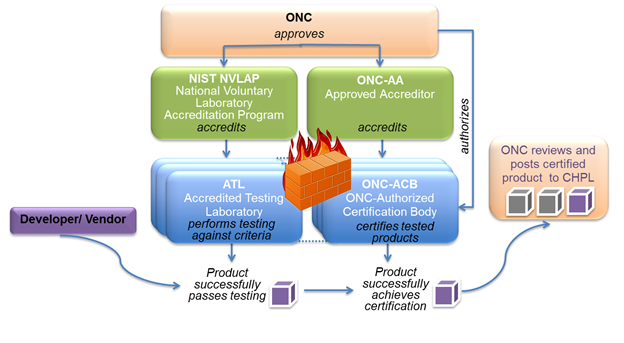ONC HIT Certification Program
Overview
The ONC Health Information Technology (HIT) Certification Program, formerly known as the Permanent Certification Program (PCP), is the second part of ONC's two-part approach to establish a transparent and objective certification process, following the Temporary Certification Program (TCP).
The TCP was established to ensure that Certified EHR Technology (CEHRT) be available for adoption by health care providers who seek to qualify for the Centers for Medicare and Medicaid Services (CMS) EHR incentive payments beginning in 2011.
The ONC HIT Certification Program became fully operational on October 4, 2012. ONC will continue to manage the overall program.
In the ONC HIT Certification Program, certification and testing activities are performed by separate entities. Certification is completed by ONC-Authorized Certification Bodies (ONC-ACBs) and testing is performed by Accredited Testing Laboratories (ATLs). Developers and Vendors first test their product with an ATL, and if their product meets the requirements, they work with an ONC-ACB to certify the product. Once the product is certified, it is submitted to ONC and ONC posts the product on the Certified Health IT Product List (CHPL).
It is possible for a single organization to serve as both an ONC-ACB and an ATL, as long as a firewall is established between testing and certification activities.
Firewall between the ONC-ACB and ATL
Additional information on certification and testing is available here.
Program Name Change
Per the Health Information Technology: Standards, Implementation Specifications, and Certification Criteria for Electronic Health Record Technology, 2014 Edition: Revisions to the Permanent Certification Program for Health Information Technology Final Rule the name of the Permanent Certification Program has been changed to the ONC HIT Certification Program.
Background
In January 2011, ONC issued the Final Rule to establish the Permanent Certification Program for Health Information Technology.
In June 2011, ONC approved the American National Standards Institute (ANSI) as the ONC-Approved Accreditor (ONC-AA) for the PCP. The ONC-AA will accredit organizations to certify EHR technology under the ONC HIT Certification Program. Once these organizations are certified by the ONC-AA, they will apply to ONC for authorization to certify EHR products. Upon authorization, these organizations will become ONC-Authorized Certification Bodies (ONC-ACBs). The National Voluntary Laboratory Accreditation Program (NVLAP) accredits testing laboratories, designating them as Accredited Testing Laboratories (ATLs) in the ONC HIT Certification Program.
More information about the ONC HIT Certification Program (PCP) is available in Final Rule: Establishment of the Permanent Certification Program for Health Information Technology [PDF - 413 KB].
Differences from the Temporary Certification Program
In the ONC HIT Certification Program, certification and testing are performed by separate entities. The graphic below further explains the differences and similarities.
The major differences and similarities between the Temporary Certification Program and the ONC HIT Certification Program
Program Structure
The graphic below shows the organizational structure of the ONC HIT Certification Program. As illustrated, ONC manages the overall program.




